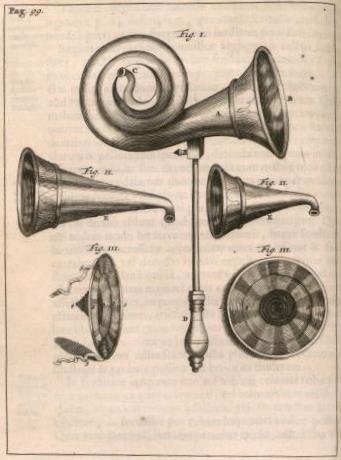
We may take it as a given that our hearing aids are scarcely detectable, can be controlled with our smartphones, and can differentiate between speech and background sound. What we might not realize, however, is that those capabilities are the products of 400 years of experiment, design, and enhancement.
Even 5 years ago, hearing aids could not deliver the clarity of sound generated at present. To understand why, let’s trace the history of hearing aids—beginning today and travelling backwards—to observe how hearing aids would have handled your hearing loss in four different years: 2016, 1985, 1940, and 1650.
2016 – Modern Digital Hearing Aids
It’s 2016 and you’re searching to treat your hearing loss. You launch a web browser, search for a community hearing care professional, submit a brief form, and schedule a consultation.
At your hearing test, your hearing is examined using sophisticated computer technology that precisely evaluates your hearing. Then, with the assistance of your hearing care expert, you select a hearing aid that fits your requirements from a wide range of models.
Then, your hearing professional programs your new hearing aids to magnify only the sounds and frequencies you have difficulty hearing, which results in crystal clear sound without distortion.
If you were to tell someone in the 1980’s that this would be the process, they wouldn’t have thought it was possible.
So what did make it possible? In short, digital technology.
For the majority of their history, there was no way for hearing aids to discern between assorted sound frequencies. Hearing aids would amplify all inbound sound, including background noise, producing distorted sound.
The digital revolution addressed that problem. With digital technology, all information can be transformed, stored, and manipulated as permutations of 0’s and 1’s. Digital technology made it possible for hearing aids to convert sound frequencies into digital information, which could then be labeled according to which sounds should be amplified (speech) and which should be suppressed (background noise).
The first all-digital hearing aid was manufactured in 1995, and since that time the technology has improved exponentially, ultimately to include wireless capability.
1985 – Transistor Hearing Aids
Now, imagine it’s 1985 and you’re seeking to treat your hearing loss. You can forget searching for a local hearing care provider on the internet because the first commercial internet service provider won’t be founded until 1989.
You would need to use the yellow pages, rely on referrals, or drive around the neighborhood to find a hearing care practice.
After scheduling a consultation and having your hearing checked, your options for hearing aids are very restricted. Without the microprocessor and digital technology, hearing aids were engineered with a series of transistors. This adds size and higher power requirements, leading to larger batteries and larger hearing aids.
Additionally, without the benefit of digital technology, the hearing aid cannot distinguish between different frequencies of sound. Hearing aids receive incoming sound and the transistors function as basic amplifiers, amplifying all sound. So if you’re in a loud room, speech recognition will be nearly impossible.
1940 – Vacuum Tube Hearing Aids
It’s 1940 and you’re thinking about buying a hearing aid. Transistors haven’t been applied to hearing aids yet, so your choices are limited to vacuum tube hearing aids.
Vacuum tubes consume more power than transistors, so the hearing aids require larger batteries, making the hearing aids big, heavy, and cumbersome.
And once again, without digital technology, the hearing aids can only act as straightforward amplification systems, making all incoming sound louder. The hearing aids can’t enrich speech and cannot filter out background noise.
1650 – Ear Trumpets
Let’s go all the way back to 1650. There’s no digital technology, no transistors, and no vacuum tubes. As a result, there is no way to convert sound into electrical currents that can be amplified.
With electrical amplification out of the question, your only choice is mechanical amplification by focusing and compressing sound into the ear, just like what takes place when you cup your hands around your ears.
By 1650, products were developed that concentrated incoming sound into the ears, and these devices were named ear trumpets. They were prominent devices with a conical end that collected sound and a narrow end that concentrated the sound into the ear.
This would be the only technology obtainable to individuals with hearing loss for the following 250 plus years.
Let’s return to 2016. Over the course of more than 400 years of history, hearing aids have evolved from mechanical amplification devices to electrical amplification devices, from vacuum-tube-based to digital-based. They’ve come to be significantly smaller, lighter, and more effective and affordable.
They’ve also become better at distinguishing among different types of sound, and in amplifying only particular types of sound (like amplifying speech while suppressing background noise).
Every generation of hearing aid has generated a significant enhancement over the previous generation. The question is, what’s the next major milestone in the history of hearing aids?
Will we soon be able to enhance natural human hearing, rather than merely restore it?